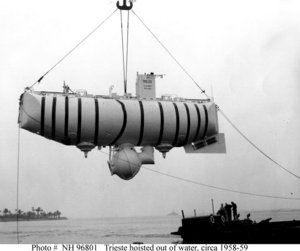Bathyscaphe Trieste
|
|
Trieste2.JPG
Trieste was a deep-diving research bathyscaphe ("deep boat") with a crew of two. Designed by the Swiss scientist Auguste Piccard, she was launched in August 1953 in the Mediterranean near Naples, Italy. She was purchased by the U.S. Navy in 1958 for $250,000.
The Trieste basically consisted of a float filled with gasoline and a separate pressure sphere. This sphere (called bathysphere by Piccard) provided just enough room for two persons and was built by the Krupp Steel Works of Essen, Germany. To withstand the staggering pressure of 9 tons per square inch (124 MPa) at the bottom of Challenger Deep, the new sphere's walls were 5 inches (127 mm) thick. It weighed 13 tons in air, 8 in water.
Transported to a new base at San Diego, she was extensively modified and then used in a series of deep-submergence tests in the Pacific Ocean during the next few years, including a dive to the Mariana Trench, the deepest known part of the ocean, in January 1960.
Trieste departed San Diego on October 5, 1959 on the way to Guam by the freighter Santa Maria to participate in Project Nekton - a series of very deep dives in the Marianas Trench.
On January 23, 1960, she reached the ocean floor in the Challenger Deep, carrying Jacques Piccard (son of Auguste) and Lieutenant Don Walsh, USN. This was the first time a ship, manned or unmanned, had reached the deepest point in the sea. The onboard systems indicated a depth of 37,800 ft (11,521 m), but this was later revised to 35,813 ft (10,916 m). (However later and more accurate measurements made in 1995 have found the Challenger Deep to be shallower, at 35,798 ft (10,911 m)). The descent took almost five hours and the two men spent barely twenty minutes on the ocean floor before undertaking the 3 hour 15 minute ascent. They observed small soles and flounders and noted the floor consisted of diatomaceous ooze while on the bottom.
Bathyscaphe_Trieste_Closeup.jpg
In April 1963, she was modified and used in the Atlantic Ocean to search for the missing submarine USS Thresher (SSN-593). In August 1963, Trieste found the wreck off New England, 8400 feet (2.56 km) below the surface. The bathyscaphe was then retired and some of her components were used in the Trieste II.
Trieste is a permanent exhibit at the Navy Museum in Washington, DC. In appearance at the time of Project Nekton she was over 50 feet (15 m) long, but the great extent of this was a series of floats filled with 22,500 US gallons (85 m3) of gasoline to provide buoyancy, and air tanks at either end of the ship. The crew were in a 6 ft (2 m) diameter steel sphere attached to the underside of the floats. An additional nine tons of pellet shot were taken on the craft to speed the descent. This additional weight was held in place by electromagnets, so that in case of an electric failure the craft would immediately start to rise to the surface.

